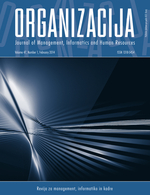Environmental Reporting and Speed of Adjustment to Target Leverage: Evidence from a Dynamic Regime Switching Model
Abstract
Background and Purpose: This study investigates the impact of environmental reporting on speed of adjustment and adjustment costs which is evaluated based on the ability of firms to adjust to target leverage level for non-financial firms listed in the Malaysian Stock Exchange (Bursa Malaysia).
Design/Methodology/ Approach: The study selects Malaysian firms based on the contracting and political cost of the economy which is seen as a relationship-based economy. This in turn influences a firm’s ability to obtain external financing and thus has an important impact on capital structure decisions. In addition, the method employed allows for a direct measure on adjustment cost for firms. The current study utilises a dynamic regime switching model based on the DPF estimator to estimate rate of adjustment to optimal target levels based on the distinction of environmental reporting of public listed firms. The approach allows statistical inferences to control for potential serial correlation, endogeneity and heterogeneity concerns which accounts for firm specific characteristics.
Results: The empirical findings suggest voluntary disclosure on environmental reporting increases a firm’s ability to access external financing at a cheaper cost as evidenced by a more rapid rate of adjustment. The findings are consistent across differing endogenous and exogenous factors indicating that these firms tend to face lower adjustment costs.
Conclusion: The current study provides a direct measure on the ability of firms to adjust to target levels via security issues and repurchases in the capital markets. This in turn is a reflection of perceived riskiness and value from the investors’ point of view in an emerging market. Prior studies have focused on environmental reporting and equity risk premiums and have not evaluated the direct impact on firm value given that the trade-off theory of capital structure predicts that firm value is maximised at target i.e. optimal levels of leverage. This study addresses the current gap in the literature by evaluating the impact on firms’ value, based on the adjustment cost.
Keywords: Environmental reporting, capital structure, speed of adjustment, DPF estimator, dynamic panel data
Design/Methodology/ Approach: The study selects Malaysian firms based on the contracting and political cost of the economy which is seen as a relationship-based economy. This in turn influences a firm’s ability to obtain external financing and thus has an important impact on capital structure decisions. In addition, the method employed allows for a direct measure on adjustment cost for firms. The current study utilises a dynamic regime switching model based on the DPF estimator to estimate rate of adjustment to optimal target levels based on the distinction of environmental reporting of public listed firms. The approach allows statistical inferences to control for potential serial correlation, endogeneity and heterogeneity concerns which accounts for firm specific characteristics.
Results: The empirical findings suggest voluntary disclosure on environmental reporting increases a firm’s ability to access external financing at a cheaper cost as evidenced by a more rapid rate of adjustment. The findings are consistent across differing endogenous and exogenous factors indicating that these firms tend to face lower adjustment costs.
Conclusion: The current study provides a direct measure on the ability of firms to adjust to target levels via security issues and repurchases in the capital markets. This in turn is a reflection of perceived riskiness and value from the investors’ point of view in an emerging market. Prior studies have focused on environmental reporting and equity risk premiums and have not evaluated the direct impact on firm value given that the trade-off theory of capital structure predicts that firm value is maximised at target i.e. optimal levels of leverage. This study addresses the current gap in the literature by evaluating the impact on firms’ value, based on the adjustment cost.
Keywords: Environmental reporting, capital structure, speed of adjustment, DPF estimator, dynamic panel data
Refbacks
- There are currently no refbacks.

